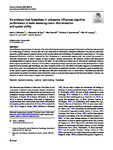No evidence that footedness in pheasants influences cognitive performance in tasks assessing colour discrimination and spatial ability
| dc.contributor.author | Whiteside, Mark | |
| dc.contributor.author | Bess, MM | |
| dc.contributor.author | Frasnelli, E | |
| dc.contributor.author | Beardsworth, CE | |
| dc.contributor.author | Langley, EJG | |
| dc.contributor.author | van Horik, JO | |
| dc.contributor.author | Madden, JR | |
| dc.date.accessioned | 2021-04-14T14:06:39Z | |
| dc.date.available | 2021-04-14T14:06:39Z | |
| dc.date.issued | 2020-03 | |
| dc.identifier.issn | 1543-4494 | |
| dc.identifier.issn | 1543-4508 | |
| dc.identifier.uri | http://hdl.handle.net/10026.1/17045 | |
| dc.description.abstract |
<jats:title>ABSTRACT</jats:title><jats:p>The differential specialization of each side of the brain facilitates the parallel processing of information and has been documented in a wide range of animals. Animals that are more lateralized as indicated by consistent preferential limb use are commonly reported to exhibit superior cognitive ability as well as other behavioural advantages. We assayed the lateralization of 135 young pheasants (<jats:italic>Phasianus colchicus</jats:italic>), indicated by their footedness in a spontaneous stepping task, and related this measure to individual performance in either 3 assays of visual or spatial learning and memory. We found no evidence that pronounced footedness enhances cognitive ability in any of the tasks. We also found no evidence that an intermediate footedness relates to better cognitive performance. This lack of relationship is surprising because previous work revealed that pheasants have a slight population bias towards right footedness, and when released into the wild, individuals with higher degrees of footedness were more likely to die. One explanation for why extreme lateralization is constrained was that it led to poorer cognitive performance, or that optimal cognitive performance was associated with some intermediate level of lateralization. This stabilizing selection could explain the pattern of moderate lateralization that is seen in most non-human species that have been studied. However, we found no evidence in this study to support this explanation.</jats:p> | |
| dc.format.extent | 84-95 | |
| dc.format.medium | ||
| dc.language | en | |
| dc.language.iso | eng | |
| dc.publisher | Springer Science and Business Media LLC | |
| dc.subject | Associative learning | |
| dc.subject | Laterality | |
| dc.subject | Spatial learning | |
| dc.subject | Footedness | |
| dc.title | No evidence that footedness in pheasants influences cognitive performance in tasks assessing colour discrimination and spatial ability | |
| dc.type | journal-article | |
| dc.type | Journal Article | |
| dc.type | Research Support, Non-U.S. Gov't | |
| plymouth.author-url | https://www.webofscience.com/api/gateway?GWVersion=2&SrcApp=PARTNER_APP&SrcAuth=LinksAMR&KeyUT=WOS:000520711400011&DestLinkType=FullRecord&DestApp=ALL_WOS&UsrCustomerID=11bb513d99f797142bcfeffcc58ea008 | |
| plymouth.issue | 1 | |
| plymouth.volume | 48 | |
| plymouth.publication-status | Published | |
| plymouth.journal | Learning & Behavior | |
| dc.identifier.doi | 10.3758/s13420-019-00402-8 | |
| plymouth.organisational-group | /Plymouth | |
| plymouth.organisational-group | /Plymouth/Faculty of Science and Engineering | |
| plymouth.organisational-group | /Plymouth/Faculty of Science and Engineering/School of Biological and Marine Sciences | |
| plymouth.organisational-group | /Plymouth/Users by role | |
| plymouth.organisational-group | /Plymouth/Users by role/Academics | |
| dc.publisher.place | United States | |
| dc.identifier.eissn | 1543-4508 | |
| dc.rights.embargoperiod | Not known | |
| rioxxterms.versionofrecord | 10.3758/s13420-019-00402-8 | |
| rioxxterms.licenseref.uri | http://www.rioxx.net/licenses/all-rights-reserved | |
| rioxxterms.type | Journal Article/Review |


